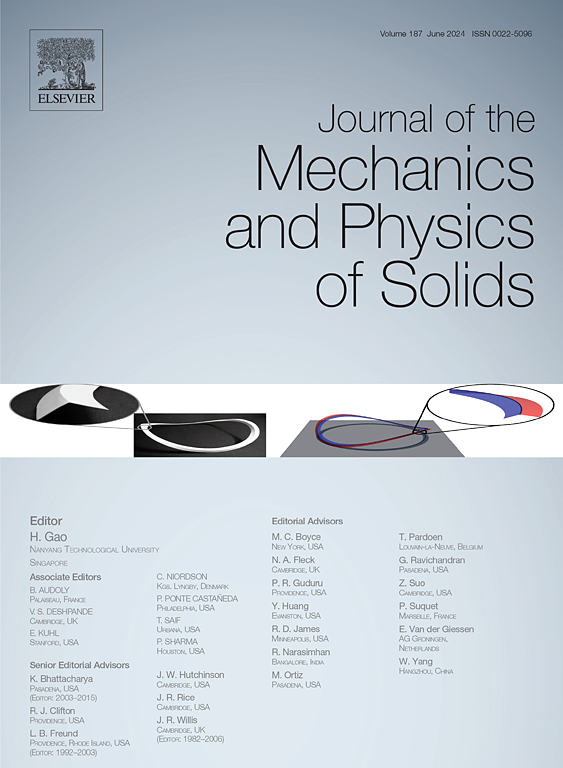Bridging statistical mechanics and thermodynamics away from equilibrium: A data-driven approach for learning internal variables and their dynamics
IF 6
2区 工程技术
Q2 MATERIALS SCIENCE, MULTIDISCIPLINARY
引用次数: 0
Abstract
Thermodynamics with internal variables is a common approach in continuum mechanics to model inelastic (i.e., non-equilibrium) material behavior. It consists of enlarging the space of the state variables by introducing internal variables to eliminate the memory effects that would otherwise arise in the constitutive response when driving the system away from equilibrium. While this approach is computationally and theoretically very attractive, it currently lacks a well-established statistical mechanics foundation. As a result, internal variables are typically chosen phenomenologically and lack a direct link to the underlying atomistic or particle description. This hinders the predictability of the ensuing continuum models as well as the inverse problem of material design. In this work, we propose a machine learning approach that directly tackles these underlying issues, by learning internal variables and the evolution equations of the system, consistently with the principles of statistical mechanics and thermodynamics. The proposed approach leverages the following machine learning techniques (i) the information bottleneck (IB) method to ensure that the learned internal variables are functions of the microstates and are capable of capturing the salient feature of the microscopic distribution; (ii) conditional normalizing flows to represent arbitrary probability distributions of the microscopic states as functions of the state variables (these will be distinct from the Boltzmann distribution away from equilibrium); and (iii) Variational Onsager Neural Networks (VONNs) to guarantee thermodynamic consistency of the learned evolution equations and that the state variables are sufficient to predict the future state of the system in the absence of memory effects. The resulting framework, called IB-VONNs, is here tested on two problems on colloidal systems, governed at the microscale by overdamped Langevin dynamics. The first one is a prototypical model for a colloidal particle in an optical trap, which can be solved analytically thanks to its simplicity, and it is thus ideal to verify the framework. The second problem is a one-dimensional phase-transforming system, whose macroscopic description still lacks a statistical mechanics foundation under general conditions. The results in both cases indicate that the proposed machine learning strategy can indeed bridge statistical mechanics and thermodynamics with internal variables away from equilibrium.
连接统计力学和热力学远离平衡:学习内部变量及其动力学的数据驱动方法
具有内变量的热力学是连续介质力学中模拟非弹性(即非平衡)材料行为的常用方法。它包括通过引入内部变量来扩大状态变量的空间,以消除在驱动系统远离平衡时本构响应中出现的记忆效应。虽然这种方法在计算和理论上都很有吸引力,但它目前缺乏一个完善的统计力学基础。因此,内部变量通常是现象学上的选择,缺乏与底层原子或粒子描述的直接联系。这阻碍了随后的连续体模型的可预测性以及材料设计的逆问题。在这项工作中,我们提出了一种机器学习方法,通过学习系统的内部变量和演化方程,与统计力学和热力学原理一致,直接解决这些潜在问题。所提出的方法利用以下机器学习技术:(1)信息瓶颈(IB)方法,以确保学习的内部变量是微观状态的函数,并且能够捕获微观分布的显著特征;(ii)条件归一化流,以表示作为状态变量函数的微观状态的任意概率分布(这些将不同于远离平衡的玻尔兹曼分布);(iii)变分Onsager神经网络(VONNs),以保证学习到的进化方程的热力学一致性,并且状态变量足以在没有记忆效应的情况下预测系统的未来状态。由此产生的框架,称为ib - vonn,在胶体系统的两个问题上进行了测试,在微观尺度上由过阻尼朗格万动力学控制。第一个是光学陷阱中胶体粒子的原型模型,由于其简单,可以解析求解,因此是验证框架的理想方法。二是一维相变系统,其宏观描述在一般条件下仍缺乏统计力学基础。这两种情况的结果都表明,所提出的机器学习策略确实可以在统计力学和热力学的内部变量远离平衡的情况下架起桥梁。
本文章由计算机程序翻译,如有差异,请以英文原文为准。
求助全文
约1分钟内获得全文
求助全文
来源期刊
CiteScore
9.80
自引率
9.40%
发文量
276
审稿时长
52 days
期刊介绍:
The aim of Journal of The Mechanics and Physics of Solids is to publish research of the highest quality and of lasting significance on the mechanics of solids. The scope is broad, from fundamental concepts in mechanics to the analysis of novel phenomena and applications. Solids are interpreted broadly to include both hard and soft materials as well as natural and synthetic structures. The approach can be theoretical, experimental or computational.This research activity sits within engineering science and the allied areas of applied mathematics, materials science, bio-mechanics, applied physics, and geophysics.
The Journal was founded in 1952 by Rodney Hill, who was its Editor-in-Chief until 1968. The topics of interest to the Journal evolve with developments in the subject but its basic ethos remains the same: to publish research of the highest quality relating to the mechanics of solids. Thus, emphasis is placed on the development of fundamental concepts of mechanics and novel applications of these concepts based on theoretical, experimental or computational approaches, drawing upon the various branches of engineering science and the allied areas within applied mathematics, materials science, structural engineering, applied physics, and geophysics.
The main purpose of the Journal is to foster scientific understanding of the processes of deformation and mechanical failure of all solid materials, both technological and natural, and the connections between these processes and their underlying physical mechanisms. In this sense, the content of the Journal should reflect the current state of the discipline in analysis, experimental observation, and numerical simulation. In the interest of achieving this goal, authors are encouraged to consider the significance of their contributions for the field of mechanics and the implications of their results, in addition to describing the details of their work.

 求助内容:
求助内容: 应助结果提醒方式:
应助结果提醒方式:


